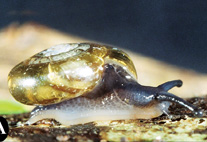Abstract
This paper provides a detailed redescription of the adult as well as the first morphological description of all juvenile instars (inclusive egg, prelarva and earlier larval stages) of Scutovertex pannonicus. The adults are characterized by their relatively large size (692–892 μm), their well developed sharply bordered foveae which are regularly distributed on the whole notogaster, except in the central field and the posterior notogastral brush-like setae ps1, h1-h3. The exochorion of the eggs shows the typical structures for the genus Scutovertex like ‘mushrooms’ and granules with the species-specific expression of the ‘mushrooms’ and its substructures. The exochorion is covered with an extra thin layer which is typical for this species. The larva and the nymphs can be distinguished from those of S. sculptus and S. minutus mainly by their lateral setae l’ and l’’ on tibia I which are strongly serrated and slightly broadened.
References
Alberti, G. & Coons, L.B. (1999) Acari: Mites. In: Harrison, F.W. & Foelix, R.F. (Eds), Microscopic Anatomy of Invertebrates, Volume 8C, Chelicerate Arthropoda. Wiley-Liss Inc. New York, pp. 515–1215.
Alberti, G., Storch, V. & Renner, H. (1981) Über den feinstrukturellen Aufbau der Milbencuticula (Acari, Arachnida). Zoologische Jahrbücher. Abteilung für Anatomie und Ontogenie der Tiere, 105, 183–236.
Grandjean, F. (1936) Les Oribates de Jean Frédéric Hermann et de son père (Arachn. Acar.). Annales de la Société Entomologique de France, 105, 27–110.
Grandjean, F. (1940) Observations sur les Oribates (14e série). Bulletin du Muséum nationale d’Histoire Naturelle Paris (2), 12, 161–169, figs. 1–3.
Grandjean, F. (1954) Observations sur les Oribates (31e série). Bulletin du Muséum nationale d’Histoire Naturelle Paris (2), 26, 582–589.
Grandjean, F. (1955) Sur un Acarien des îles Kerguélen. Podacarus auberti (Oribate). Memoires du Museum National d’Histoire naturelle. (n.s.), série A, Zoologie, 8, 109–150.
Grandjean, F. (1956a) Caractères chitineux de l’ovipositeur, en structure normale, chez les oribates (Acariens). Archives de Zoologie experimentale et generale, 93, Notes et Revues, 2, 96–106.
Grandjean, F. (1956b) Observations sur les Oribates (34e série). Bulletin du Muséum nationale d’Histoire Naturelle Paris (2), 28, 205–212.
Grandjean, F. (1957) Observations sur les Oribates (37e série). Bulletin du Muséum nationale d’Histoire Naturelle Paris (2), 29, 88–95.
Krantz, G.W. & Walter, D.E. (2009) A manual of Acarology. 3rd edition. Texas Tech University Press, Lubbock, Texas, 807 pp.
Krisper, G. & Schuster, R. (2008) Fortuynia atlantica sp. nov., a thalassobiontic oribatid mite from the rocky coast of the Bermuda Islands (Acari: Oribatida: Fortuynidae). Annales Zoologici (Warszawa), 58, 419–432. http://dx.doi.org/10.3161/000345408X326753
Krisper, G., Pfingstl, T. & Ebermann, E. (2008) SEM-Investigations on the exochorion of scutoverticid eggs. Soil Organisms, 80, 217–221.
Norton, R.A. (1977) A review of F. Grandjean’s system of leg chaetotaxy in the Oribatei and its application to the Damaeidae. In: Dindal, D. L. (Ed), Biology of Oribatid Mites. State University of New York, Syracuse, New York, pp. 33–62.
Norton, R.A., Alberti, G., Weigmann, G. & Woas, S. (1997) Porose integumental organs of oribatid mites (Acari, Oribatida): 1. Overview of types and distribution. Zoologica (Stuttgart), 146, 1–31.
Norton, R.A., Behan-Pelletier, V. & Wang, H.-F. (1996) The aquatic oribatid mite genus Mucronothrus in Canada and the Western U.S.A (Acari: Trhypochthoniidae). Canadian Journal of Zoology, 74, 926–949. http://dx.doi.org/10.1139/z96-106
Oliveira, A.R., Norton, R.A., de Moraes, G.J. & Faccini, J.L.H. (2007) Preliminary observations on courtship behavior in Mochloribatula (Oribatida: Mochlozetidae). In: Morales-Malacara, J.B., Behan-Pelletier, V., Ueckermann, F., Pérez, T.M., Estrada-Venegas, E.G. & Badii, M. (Eds) Acarology XI: Proceedings of the International Congress. Instituto de Biologia and Facultad de Ciencias, UNAM, Sociedad Latinoamericana de Acarologia, Mexico, pp. 715–718.
Pfingstl, T., Schäffer, S., Ebermann, E. & Krisper, G. (2008) Intraspecific morphological variation of Scutovertex sculptus Michael (Acari: Oribatida: Scutoverticidae) and description of its juvenile stages. Zootaxa, 1829, 31–51.
Pfingstl, T., Schäffer, S., Ebermann, E. & Krisper, G. (2009) Differentiation between two epilittoral species, Scutovertex arenocolus spec. nov. and Scutovertex pilosetosus Poldermann (Acari: Oribatida) from different European coasts. Zootaxa, 2153, 35–54.
Polderman, P.J.G. (1977) Scutovertex pilosetosus nov. spec. from the Netherlands (Acari, Oribatida). Entomologische Berichten, Amsterdam, 37, 129–132.
Raspotnig, G. (2006) Chemical alarm and defence in the oribatid mite Collohmannia gigantea (Acari: Oribatida). Experimental and Applied Acarology, 39, 177–194. http://dx.doi.org/10.1007/s10493-006-9015-4
Schäffer, S. & Krisper, G. (2007) Morphological analysis of the adult and juvenile instars of Scutovertex minutus (Acari, Oribatida, Scutoverticidae). Revue Suisse de Zoologie, 114, 663–683.
Schäffer, S., Krisper, G., Pfingstl, T. & Sturmbauer, C. (2008) Description of Scutovertex pileatus sp. nov. (Acari, Oribatida, Scutoverticidae) and molecular phylogenetic investigation of congeneric species in Austria. Zoologischer Anzeiger, 247, 249–258. http://dx.doi.org/10.1016/j.jcz.2008.02.001
Schubart, H. (1975) Morphologische Grundlagen für die Klärung der Verwandtschaftsbeziehungen innerhalb der Milbenfamilie Ameronothridae (Acari, Oribatei). Zoologica, 123, 23–91.
Schuster, R. (1958) Beitrag zur Kenntnis der Milbenfauna (Oribatei) in pannonischen Trockenböden. Sitzungsberichte der Österreichischen Akademie der Wissenschaften, mathematisch-naturwissenschaftliche Klasse, Abteilung 1, 167, 221–235.
Schuster, R. (1959) Ökologisch-faunistische Untersuchungen an bodenbewohnenden Kleinarthropoden (speziell Oribatiden) des Salzlachengebietes im Seewinkel. Sitzungsberichte der Österreichischen Akademie der Wissenschaften, mathematisch-naturwissenschaftliche Klasse, Abteilung 1, 168, 27–78.
Schuster, R. (1997) Type material of soil mite species described in the period 1957–1965. EURAAC Newsletter, 9 (2/3), 4–8.
Shtanchaeva, U.Ya. & Netuzhilin, I.A. (2003) A Review of the world fauna of Scutoverticidae Oribatid Mites (Acari, Oribatida) with description of new species. Zoologicheskii-Zhurnal, 82, 781–803.
Søvik, G. (2004) The biology and life history of arctic populations of the littoral mite Ameronothrus lineatus (Acari, Oribatida). Experimental and Applied Acarology, 34, 3–20. http://dx.doi.org/10.1023/B:APPA.0000044436.80588.96
Wallwork, J.A. (1977) The structure of the ovipositor and the mechanics of oviposition in the oribatid mite Machadobelba symmetrica Bal. (Acari: Cryptostigmata). Acarologia, 19, 149–154.
Woas, S. (2002) Acari: Oribatida. In: Adis, J. (Ed), Amazonian Arachnida and Myriapoda. Identification keys to all classes, orders, families, some genera, and lists of known terrestrial species. Pensoft Series Faunistica No 24, Sofia, pp. 21–291.

